#pleuronectiformes
Text
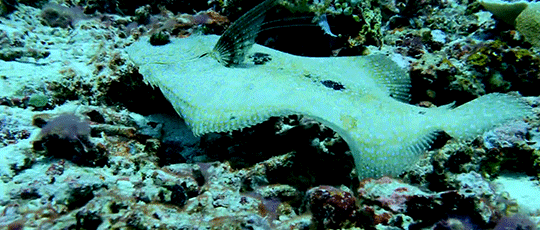
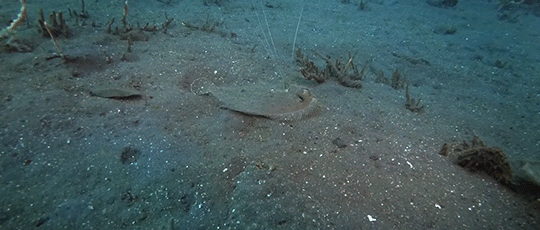
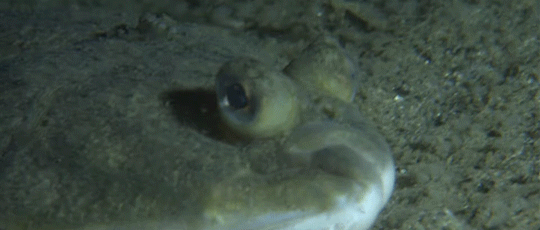

Flounders are demersal fish, meaning they live and feed on or near the bottom of bodies of water. Their distinctive shape is an obvious benefit for this lifestyle.
©Nature Footage
61 notes
·
View notes
Text

Strange Symmetries #18: Flat Fish Friday
Modern flatfish are characterized by their highly asymmetrical skulls, with both eyes positioned on just one side of their head. They aren't actually born this way, but instead they undergo "eye migration" as juveniles, twisting up their skulls to bring one eye across the top of the head.
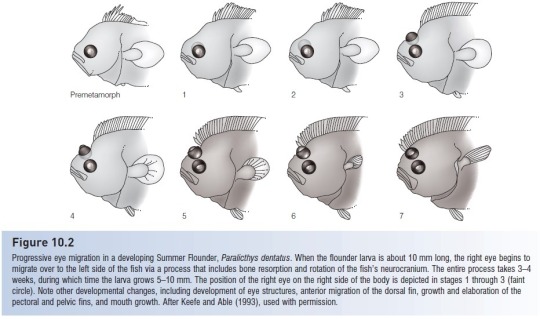
Progressive eye migration in a developing Summer Flounder, Paralicthys dentatus.
From Helfman et al (2009). The diversity of fishes. 2nd ed., Wiley-Blackwell.
This bizarre arrangement is the result of flatfish adapting to life laying flat on the seafloor, but instead of slowly widening and flattening themselves out they took an evolutionary "shortcut" by simply tipping their tall narrow bodies over onto one side. Initially this would have left one of their eyes unusable, but random mutations causing slightly asymmetrical skulls would have rapidly become highly advantageous to the earliest members of this lineage – and over time they just got wonkier and wonkier.
We've even found fossils of early flatfish in the "halfway there" stage of their evolution!
Amphistium paradoxum lived in what is now northern Italy during the Eocene, around 50-48 million years ago. About 20cm long (~8"), it had one eye partially migrated towards the top of its head, but not all the way around yet, showing a transitional state between its bilaterally symmetric ancestors and its more twisted-skulled modern relatives.
Unlike most modern flatfish Amphistium came in both "right-eyed" and "left-eyed" forms in equal numbers, suggesting that a genetic preference for a specific side also hadn't developed yet.
———
NixIllustration.com | Tumblr | Twitter | Patreon
#science illustration#strange symmetries#paleontology#paleoart#palaeoblr#amphistium#pleuronectiformes#flatfish#actinopterygii#fish#art#flat fuck friday
341 notes
·
View notes
Text
Taxonomy Tournament: Fish

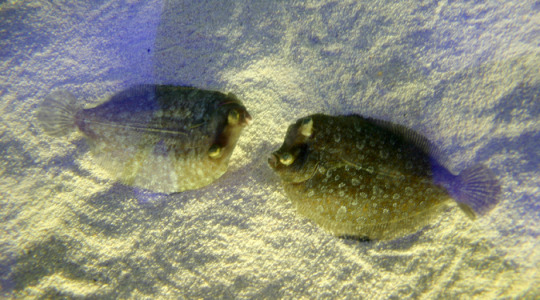
Carangiformes. This order contains the aggressively predatory dolphinfishes, and remoras, which have a sucker-like dorsal fin that allows them to attach to a larger host animal.
Pleuronectiformes. This order is made up of flatfishes, wuch as the flounder and halibut.
#animals#biology#polls#poll tournament#zoology#remoras#fish#flounders#halibut#Carangiformes#Pleuronectiformes#0x7cv0x83#animal tournament#Animal Tournament Round 1
28 notes
·
View notes
Text
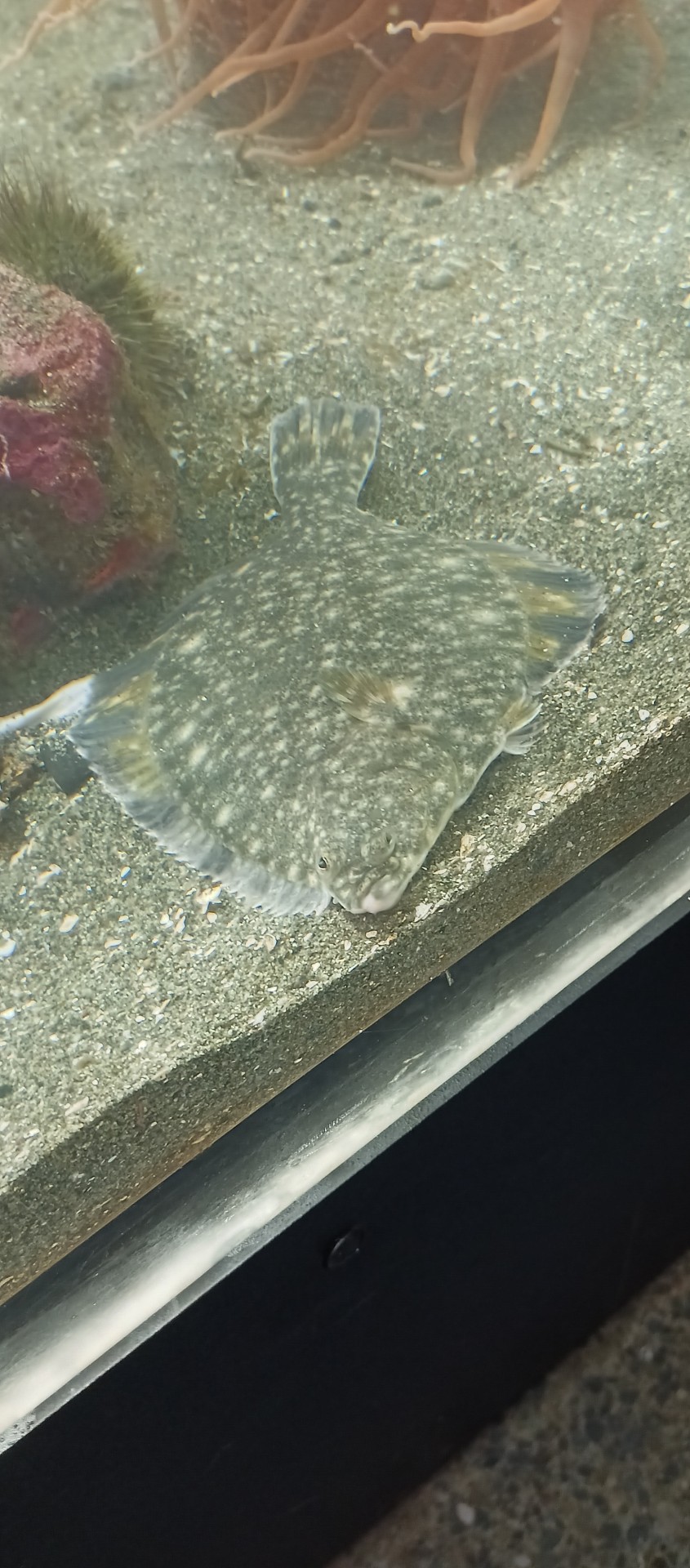
Starry flounder (Platichthys stellatus)
#starry flounder#eukarya#animalia#chordates#actinopterygii#pleuronectiformes#pleuronectidae#platichthys#platichthys stellatus#p. stellatus#flatfish#flounder
13 notes
·
View notes
Text

Amphistium
Amphistium — вимерлий рід променеперих риб ряду Камбалоподібні (Pleuronectiformes). Типовий вид — Amphistium paradoxum. Він вважається базальною формою камбалоподібних та перехідною формою від окунеподібних риб. На відміну від сучасних камбалових, у Amphistium очі не повністю зміщені на одну сторону голови, зокрема одне око розміщене на верхній частині голови.
Повний текст на сайті "Вимерлий світ":
https://extinctworld.in.ua/amphistium/
#amphistium#fish#pleuronectiformes#ua#actinopterygii#eocene#italy#verona#art#paleontology#paleoart#prehistoric#палеоарт#палеонтологія#ukraine#ukrainian#prehistory#science#illustration#daily#digital art#creatures#extinct#fossils#україна#мова#українська мова#український тамблер#арт#риби
8 notes
·
View notes
Text
Uncharismatic Fact of the Day
Hey everyone! In an attempt to bring a little more fun education, I’m going to start posting a daily fun fact in addition to our usual species-focused posts. Our first fun fact:
Flounders, a group of fish famous for their sideways appearance, don’t start out that way! As hatchlings they have one eye on each side of their head, as most animals do. Then, as they get older and become bottom-dwellers, one eye migrates to the other side of their body! The side that becomes their ‘top’ is based on which way the flounder leans while it swims as a juvenile.
youtube
(Video credit: Dr. Alexander Schreiber, flatfish metamorphosis begins at 0:26)
46 notes
·
View notes
Text

Halibut
By: Van Kooles / Jacana Press Agency
From: Éditions Rencontre Cards
1976
#captivity#fave#halibut#pleuronectiform#bony fish#fish#1976#1970s#Van Kooles#Jacana Press Agency#Éditions Rencontre Cards
48 notes
·
View notes
Text
Daily fish fact #293
Flatfish!

Flatfish, also known as the order Pleuronectiformes, are born as normal-looking fish! However, as they mature, one of their eyes moves to either side of their body; in some species the eye moves to the right side and in some species the left! There's also species where either option is just as likely.
#fish#fishfact#fish facts#fishblr#marine animals#marine life#marine biology#sea creatures#sea life#sea animals#biology#zoology#flatfish
211 notes
·
View notes
Text
Animal Crossing Fish Dish Friday - #14
Brought to you by a marine biologist and a bunch of weird flat bois...
CLICK HERE FOR THE AC FISH EXPLAINED MASTERPOST!
Olive Flounder Meuniere

In ACNH: 1. Get Turkey Day Recipes - Franklin will give you this recipe after you've helped him cook all of Turkey Day's meals. Funny that on Turkey Day, the main ingredient is Sea Bass + a random fish from 3 choices (for Northern Hemisphere players) or Squid and Sea Urchin (for Southern Hemisphere). The recipe you get is for Olive Flounder.
2. Cook on the stove with 1 Olive Flounder and 2 Flour.
In Real Life: from France
Species of Choice: It can be any flounder species - the more native to you, the better. Flat fish come in many names and many species, as I'll explain below, but most of them available for people to eat present flaky, white meat that most people associate with a "good fish".
Other Ingredients:
Butter
Parsley
Lemon
White or Corn Flour
Get the recipe. and serve with a hot veggie and bread.
This will be long because of pictures. A long, long time ago, in an article far away, we covered how flatfish, like the Olive Flounder, become to look so ridiculous. I also pointed out and explained the differences between left-eye and right-eye flounders in the article covering the Dab. These things will be important as we move on to our next lesson about flatfish.
With over 800 species, the Order of Pleuronectiformes, the flounders, has a lot of diversity. Even though most* of these fish are flat and have both eyes on one side of the head, they come in some interesting shapes. We'll start with the tame and end with the weirdos.
Flounders - SubOrder Plueronectoidei
The name "flounder" is used for many flatfish that are important to fisheries/seafood. Even still, these are also quite diverse, not just because both right-eyed and left-eyed flatfish are called flounders, but because they also occupy different niches. Some of them have tiny mouths great for eating tiny fish and plankton, and then some are higher-trophic-level predators with huge mouths and teeth!
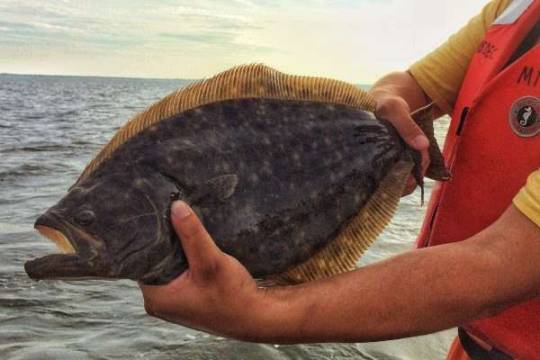

^These two fish are native to my neck of the ocean. Big differences in the mouth, right?
There are also 4 special flounders in this group called "Plaice".
Halibut - Genera Hippoglossus & Reinhardtius
The term halibut is reserved for the largest flatfish species, of which there are 3 - the Atlantic Halibut and Pacific Halibut in Genus Hippoglossus, and the Greenland Halibut in Genus Reinhardtius. They are absolutely massive, growing to 9 feet (3m) for some individuals. When you eat halibut, you're getting a very tiny portion of that fish. But size isn't the only way to tell them apart from other flatfish - they also have tail fins with longer, sharper points for fast swimming, and all 3 are "right-eyed" flatfish.

By Jlikes2Fish - Own work, Public Domain
Turbots - Family Scophthalmidae
Okay, now we're getting away from special flounders, and into new Families. The turbots are also called windowpanes or brill, but the biggest difference between them and other flatfish is their more rhombus or stout shape, rather than the elongated oval-shape of most other flatfish. Their shape is not really a scientific trait, but we're going for "first glance" here. These are also eaten widely.

By I, Luc Viatour, CC BY-SA 3.0
Soles - Family Soleidae & Achiridae
The fish in Soleidae are the true soles, with fish in Achiridae known as the American Soles, once classified within Soleidae. Either way, soles make up about 180 species and here's where we start to get weird. They often have more tear-drop-shaped bodies (but some can be really kind of square or round like a turbot) and very tiny or non-existent pectoral fins. These are also commonly eaten and they "right-eyed". They also have these weird mouths...just look at the picture...

By © Hans Hillewaert, CC BY-SA 4.0
It's all, like, lip-less? And beak-shaped? They have jaws - of course - but whenever I've had to handle our tiny, native sole here on Long Island, I'm always a bit surprised at it. But yeah, that's a thing they have in common with the last group.
Tonguefish - Family Cynglossidae
Here we are - the last group and the weirdest of the bunch. I think these take the flatfish body plan to the extreme and they have a number of traits that set them apart from other flatfish. These guys also have that beak or hook-shape to the upper jaw, but it's flabby, so it's weird. It's like its body is slowly trying to turn the mouth with the eyes (who knows...maybe in millions of years, it will be!) These guys are "left-eyed" and have no pectoral fins at all. They're just...really weird.

It doesn't even look like a fish anymore. I hope ACPC makes one someday.
And there you have it - so many flat bois!
#animal crossing#animal crossing pocket camp#flounder#olive flounder meuniere#turbot#halibut#tonguefish#sole#flatfish#fish#cooking#marine biology#science in video games#maybe not as I went on a tangent#oh well#animal crossing fish explained
18 notes
·
View notes
Text
*about to ask my surgeon to put both my nipples back on one side* are you familiar with the order pleuronectiformes?
4 notes
·
View notes
Photo


Hunter flounder are easy enough to see when they’re swimming, but what about the one that didn’t move?
BBC Earth
15 notes
·
View notes
Text
The hogchoker
The hogchoker (Trinectes maculatus) is one of the few true flatfishes or pleuronectiforms, that are encountered in the aquarium trade. In North America, where the species is native, it is distributed from Massachusetts down to Panama, and hogchokers turn up in retailers tanks fairly regularly, as "freshwater flounders". Elsewhere they are a rare import.
In the USA, it is wild caught juvenile hogchokers, that are the most often traded as, a freshwater fish. This is unfortunate, because the adult flounders can be found far upstream, but juveniles are strictly estuarine in the wild, inhabiting only estuarine waters with a specific gravity of 1.00, during the summer months. Juvenile hogchokers do survive and grow in freshwater environments, but it is suboptimal for their growth rate, because it creates higher metabolic stresses for them. Ideally, juveniles should be maintained in mildly brackish aquaria only, and at a temperture of perhaps 22-26 degrees centigrade, based on the summer water tempertures, wild hogchokers would encounter in such habitats.
Adult hogchokers show no preferences of salinity at such tempertures, being fine at a specific gravity of 0 (freshwater) or of up to 1.02. Typically, the water tempertures experienced by wild hogchokers, may be as low as 2 degrees centigrade in wintertime, but as high as, around 24 degrees in the summertime. At a temperture of 15 degrees, hogchokers grow best at a specific gravity of 1.01 to 1.02. Whereas at 35 degrees, a temperture that wild hogchokers rarely encounter, except in the southern part of their distribution, they put on more weight in freshwater conditions.
The hogchoker grows only to 20 centimeters, or 8 inches, and prefers small prey in the wild, feeding on polychaetes, small arthropods, and tellinid clam siphons. Where they are available, polychaetes seem to be their primary prey resource, followed by amphipod crustaceans. Trinectes may need acclimatising to a captive diet, but this can be done, and they consume suitably sized meaty morsels.
The species is common on sandy bottoms, but is also rokerant of muddier or siltier bottoms in the wild. Such conditions should be replicated in the aquarium, if the hogchoker is to be maintained. They may be bothered or even I jured, by fishes that nip at the substrate, or are very active at the bottom of the water column. And as predators, hogchokers may themselves consume very small tankmates, intended as ornamental additions.
0 notes
Text
Sabías que el gallo común es un pescado blanco de agua salada y pleuronectiforme.

#menudeldia #dondesiemprecaridad #comidacasera #Madrid #distritoPacífico #conejoguisado #miercoles
0 notes
Note
hello it is I please tell me about flatfish chromatophores -@iwannabeasixgillshark
Oh boy, so: Flatfish possess chromatophores. They are special cells that can change color. They use these to adapt their scale pattern to blend in with the substrate they're on. Amazing stuff, and really important, too. Flatfish are demersal ambush predators and prey. Hiding is essential to survival. But have you wondered how they are able to change color? Is is a conscious or unconscious process? How do all of those cells coordinate? I may have some answers!
I dug into a research paper by Derek Burton [1] which examined the physiological mechanisms of flatfish chromatophores in great detail. It is the source of all I'm about to share.
Let's begin with taxonomy! What is a flatfish? A flatfish is a teleost in the order of Pleuronectiformes. They are characterized by their asymmetrical body plan as adults, where one eye migrates to the other side of the head during metamorphosis. They lie flat on the sea floor. The blind side is characteristically a pale white, whereas the dominant side is covered with color-changing scales. The dorsal and anal fins run the length of the body on the dorsal and ventral sides. The fins have highly articulate spines that allow them to prop themselves up, crawl, and through substrate over themselves and become buried.
That's neat! Now, not all chromatophores are alike. Some are responsible for specific pigments and colors, some react to neurotransmitters more than the other. So how many types are there on a flatfish? Five! There are epidermal melanophores, dermal melanophores, xanthophores, iridiphores, and erythrophores. Clusters of these different cells are present in different proportions on a flatfish's body, and give each one a distinct base pattern; between species, and between individuals. Here's what these grouping look like:
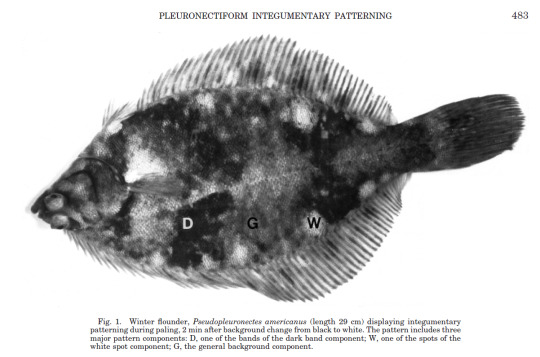
And here are the proportions of cells that make up all of these distinct clusters:

The cell type that stands out the most in this graph is the great concentration of iridiphores in the white spots. As a matter of fact, the blind side of a flatfish is mostly made up of iridiphores! Why are they so bright? Well, these cells contain elongate crystals of guanin; a copper-gold allow. Shiny! These crystals can become covered by melanosomes in order to reduce their prominence. Notice how the density of iridiphores decreases from white to dark.
Iridiphores are relatively inflexible when it comes to color change. But there are other cells that can take up that mantle: those present in the general scaling.
Before I start talking about hormones and neurotransmitters, I'd like to mention that flatfish are not the only fish who possess chromatophores. Salmon and tilapia possess these cells, as well as others. Control of their pigment is largely hormonal, though. Given the importance of a flatfish's camouflage, they have adapted greater control over their colorful dermal cells. Their changes have some hormonal factor, but it is largely neurons that manage this complex active camo system.
I spent hours making this schematic specifically for this purpose, so behold:
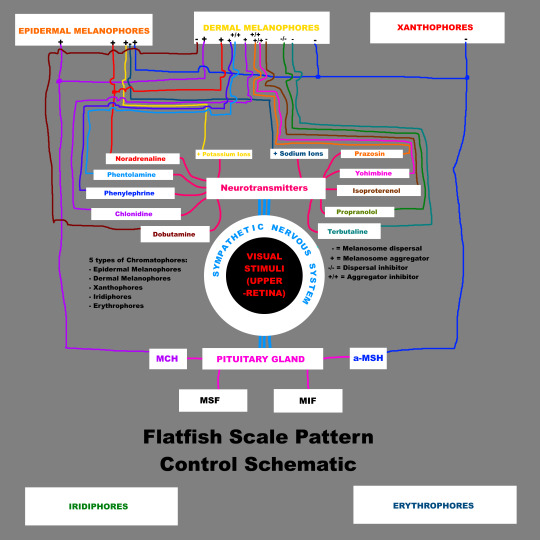
It's a lot to take in. It was a lot to sort. I had to make a truth table of cells and stimuli, and sort out which effect one had on the other. This is not entirely comprehensive, either! Depending on which group these cells are in, they react more quickly or more slowly to these stimuli. For example: Melanosome concentration in melanophores in the dark band group reacted quickly when the background the flatfish was on changed from white to black. White-spot melanophores respond more rapidly to noradrenaline than dark band melanophores. If you wanna know how each cell responds to each stimuli, check out the paper!
Following my colorful graphic, we can see that the chain begins with visual stimuli. A flatfish settles in a new area of sea floor. The sun is rising and the colors of the substrate become more visible. This signal is processed by the autonomic nervous system, specifically the sympathetic nervous system. Unconsciously, in the background, the work of adapting the scale's color and pigment starts. Melanin hormones are released from the pituitary gland as necessary to achieve the desired change, and neurotransmitter are released such that the right scales become the right hue and brightness. This could take dozens of minutes or hours, but it happens. The flatfish is now well adapted to its new environment.
If that isn't the most fascinating thing to you, I don't know what else to tell ya! There many more questions to be answered, and this is just a simplified overview of the general physiology at play. In my future research, I will set out to determine which substrate colors and patterns are imitated by flatfish by using complex images featuring various shapes and colors.
[1] DEREK BURTON, 2002; The Physiology of Flatfish Chromatophores
#pleuronectiformes#teleost#bony fish#ray finned fish#flatfish#turbot#plaice#halibut#sole#flounder#dab#sanddab#marine biology#chromatophores#physiology
18 notes
·
View notes
Photo

The Baltic flounder (Platichthys solemdali) is a newly-discovered flatfish species, and according to researchers is the first endemic fish known from the Baltic Sea, the description of this new species is published in the journal Frontiers in Marine Science.

- Adult female in dorsal view before fixation. photo by P. Momigliano.
The Baltic flounder has a wide distribution in coastal and bank areas across the region up to the Gulf of Finland and the southern Bothnian Sea. It is found in shallow water on soft and hard bottoms. Adult Baltic flounders measure between 20-25 cm in length. The right-eyed side form is predominant in this species.
Photo: Baltic flounder in its environment photo by Mats Westerbom.
Reference (Open Access): Momigliano et al., 2018. Platichthys solemdali sp. nov. (Actinopterygii, Pleuronectiformes): A New Flounder Species From the Baltic Sea. Front. Mar. Sci
#Platichthys solemdali#baltic flounder#Platichthys#new species#Actinopterygii#Pleuronectiformes#science#scienceblr#sciblr#biology#marine biology
117 notes
·
View notes
Photo

A pair of larval Bothidae flatfish, or left-eyed flounder, swim upright in what will be fleeting phase of body symmetry. Before long, these larvae will undergo an astounding transformation in which one of the fish’s eyes migrates to the other side of the head
Photo: Solvin Zankl
#Animal#Fish#Flatfish#Flounder#Chordata#Vertebrate#Gnathostomata#Eugnathostomata#Teleostomi#Osteichthyes#Actinopterygii#Neopterygii#Teleost#Acanthomorpha#Acanthopterygii#Pleuronectiformes#Pleuronectoidei#Pleuronectoidea#Bothidae#Left Eye Flounder
1 note
·
View note